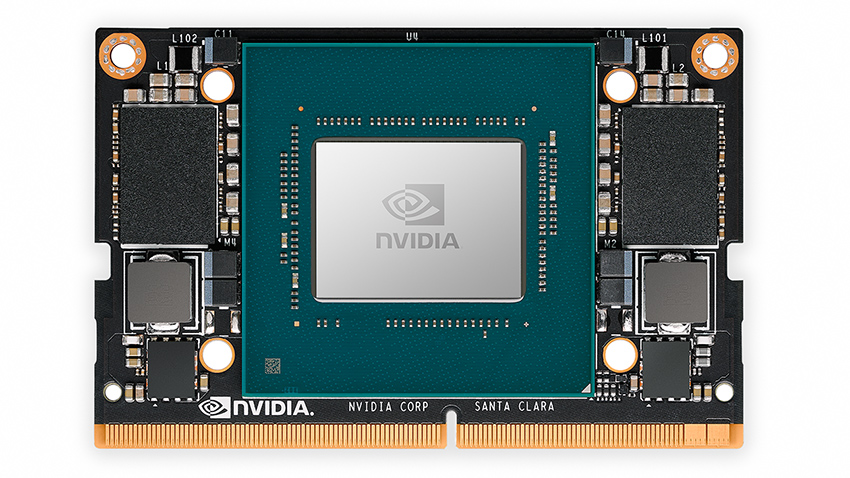Product of the Week: Apollo Audio/Video AI Engineering Kit from SmartCow
March 22, 2022
Story

Market research estimates the natural language processing market will grow from $20.98 billion in 2021 to more than $127 billion in 2028. Similarly, the AI vision market is expected to grow to $144.46 billion from $7.04 billion in 2020.
Clearly, artificial sensory perception is on the rise.
For developers building visual and conversational computing systems, the Smart Cow Apollo AI Engineering Kit factors the NVIDIA Jetson Xavier NX computing module’s 21 TOPS of performance and four microphones, two speaker terminals, two 3.5mm phone jacks, an 8MP camera module, an OLED display, and a 128 GB NVMe SSD into the equation.

Built on a 384-core Volta GPU with 48 tensor cores and six-core NVIDIA Carmel Arm v8 CPU with 10 MB of combined L2 and L3 cache, the Apollo kit’s featured NVIDIA Jetson Xavier NX computing module pairs with the NVIDIA Riva, DeepStream, and JetPack SDKs out of the box to accelerate the creation of edge AI-based automatic speech recognition (ASR) and natural language processing (NLP) solutions.

This performance is augmented by two PVA vision accelerators, two deep learning accelerators, H.264 and H.265 video encoders/decoders. High-speed data transfers can also make use of between 8 GB and 16 GB of 128-bit LPDDR4x memory that operates at up to 60 Gbps, or make things more permanent by using 16 GB of onboard eMMC 5.1 flash.
Of course, what makes the Apollo Kit unique is everything else around it:
- Its 4x MEMS microphones are supported by a built-in audio codec
- The 8MP IMX179 camera module supports multiple vision apps
- A 2.08-inch OLED display shows status and other readings
- An included 128 GB NVMe SSD is pre-packed with the aforementioned NVIDIA SDKs
- A baseframe allows it to stand upright for ergonomic engineering
The SmartCow Apollo Audio/Video Engineering Kit in Action:
Developers looking to prototype perception-based applications can gain access to Apollo Kit resources via 40-pin headers on the front of the device or USB ports on the side. There’s also an Ethernet RJ45 jack on the kit for users looking to add an element of networking to their project.
With system access, engineers can begin taking advantage of all the software capabilities afforded by the NVIDIA SDKs almost immediately. Not only do Riva, DeepStream, and the JetPack SDK provide frameworks that simplifying application development, in many cases SmartCow has implemented ready-to-run demos and use case-optimized AI models on the kit to help get you off the ground.
For example:
- An ASR example leverages the NVIDIA Citrinet model to transcribe spoken language (speech-to-text)
- An NLP sample application based on an open-source NLTK model analyzes text data to determine how positive or negative the input text is, the application will display an emoting cow on the OLED screen. This setup also supports Named Entity Recognition (NER), a process that determines named entities from sentences.
- A third chatbot demo utilizes the Chatterbot open-source GitHub repository to create two chatbot instances on the Jetson that communicate with one another. Users can run other NLP tasks such as sentiment analysis on the text generated by the chatbots and use text-to-speech on the generated text.
Other software that comes with the kit includes the Gstreamer (webRTC) open-source multimedia framework examples for audio-visual AI applications and a host Ubuntu Linux OS.
New examples will be added on a regular basis. More about these demos can be seen in the video below.
Getting Started with the Apollo Audio/Video AI Engineering Kit
The Apollo Audio/Video AI Engineering Kit measures in at 81 x 69 x 125 mm, so all you really need to get started is that much space on your workbench and a development PC.
Apollo will begin shipping on April 8th, so you’ll want to reserve your spot in line by filling out the form on the Apollo Engineering Kit microsite. Otherwise, you can learn more by checking out further kit specifications, demos, and tutorials in their Apollo Getting Started page, tuning into the NVIDIA’s GPU technology Conference (GTC) on March 21 – 24 where it will be on display, or via the resources below.
- SmartCow Apollo Engineering Kit Product Page: www.apollo.smartcow.ai
- SmartCow Apollo Apollo Engineering Kit Video Tutorials: https://youtube.com/playlist?list=PLCsG-Qluyt780LZY22_LXEXLKqYzJsdPm
- NVIDIA Jetson Xavier NX Product Page: www.nvidia.com/en-us/autonomous-machines/embedded-systems/jetson-xavier-nx
- NVIDIA JetPack SDK: https://developer.nvidia.com/embedded/jetpack
- NVIDIA DeepStream SDK: https://developer.nvidia.com/deepstream-sdk
- NVIDIA Riva SDK: https://developer.nvidia.com/riva




